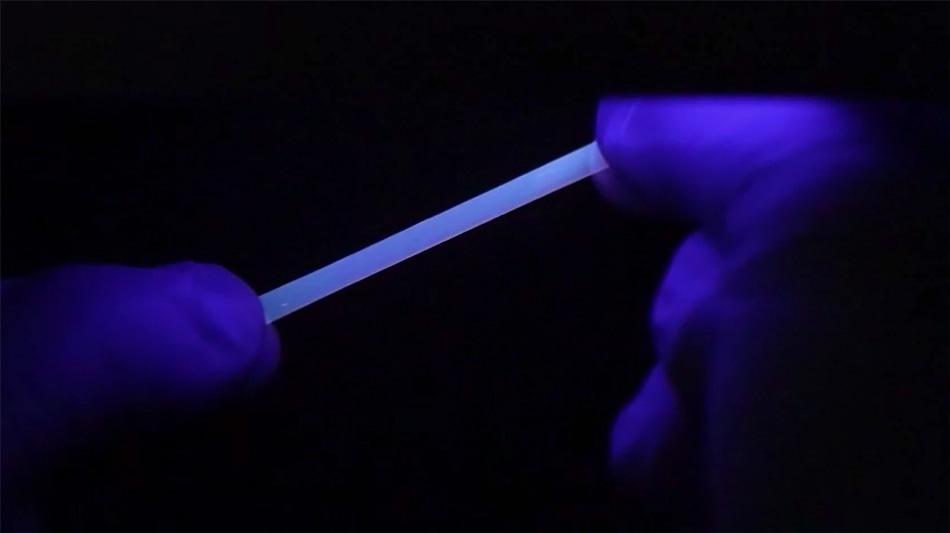Apr 25 2019
Scientists at the University of Fribourg’s Adolphe Merkle Institute (AMI) and Hokkaido University in Japan have created a technique to modify the properties of stress-indicating molecules that can be incorporated into polymers and signal damages or too much mechanical loads with an optical signal.
 The newly developed polymer switches on and off its fluorescence responding to mechanical stress. (Image credit: Hokkaido University)
The newly developed polymer switches on and off its fluorescence responding to mechanical stress. (Image credit: Hokkaido University)
In their study carried out within the National Center of Competence in Research Bio-inspired Materials, Professor Christoph Weder, the chair of Polymer Chemistry and Materials at AMI, and his group have been studying polymers that change their color or fluorescence characteristics when subjected to mechanical load.
The existing method to accomplish this operation is based on uniquely designed sensor molecules that consist of weak chemical bonds that break when the applied mechanical force goes beyond a particular threshold. This effect can lead to a color change or other pre-defined responses. However, a major drawback of this method is that when exposed to heat or light, the weak bonds can also break. Due to this lack of specificity, the practical usefulness of stress-indicating polymers is minimized. Moreover, it usually makes the effect irreversible.
In order to tackle this issue, Weder and Dr Yoshimitsu Sagara—a Japanese researcher who worked for two years in Weder’s group at AMI before joining Hokkaido University as an Assistant Professor—developed a new kind of sensor molecule that can only be stimulated by mechanical force.
In contrast to previous force-transducing molecules, there is no breaking of chemical bond. Rather, the new sensor molecules have two parts that are mechanically interconnected. This interconnection inhibits the separation of the two parts, while still enabling them to be attracted together or repelled away from each other. Such molecular attraction and repulsion cause the molecule’s fluorescence to switch from off to on.
In a new release in the open-access journal ACS Central Science, Weder, Sagara, and their co-workers state that this new idea is versatile and robust.
The design approach allows one to tailor the properties of such sensor molecules, as their behavior is quite predictable.
Professor Christoph Weder, Chair of Polymer Chemistry and Materials, AMI
We chose to demonstrate this by tackling materials that display white fluorescence when stretched. Mechanoresponsive white fluorescence is in general difficult to achieve. It requires the combination of three sensor molecules with pre-defined emission colors: blue, green, and red (or orange). In addition, the sensor molecules also need to exhibit a similar response to mechanical stress to achieve ON/OFF switching of white emission when they are blended.
Dr Yoshimitsu Sagara, Assistant Professor, Hokkaido University
As proposed, polymers that consist of the new motifs do not fluoresce when there is no mechanical force, but they become brightly fluorescent—red, green, or blue, when only one kind of sensor molecule was used, white when they were combined—when extended. As there is no breaking of chemical bonds, the process is also completely reversible.
Therefore, when the new sensor molecules were integrated into an elastic polymer and when it was extended, the fluorescence was turned on, and when the force was removed and the material contracted, the fluorescence was turned off. Furthermore, the fluorescence intensity, or brightness, was established to relate to the extent of deformation.
Promising applications for these materials are integrated monitors that transmit visual warning signs before a part stops working, or that allow engineers to record stresses in parts under load and help them design these better. In addition, the sensor molecules hold potential for basic, molecular-level studies of stress-transfer mechanisms in synthetic materials as well as in biological systems.
Now the Swiss-Japanese group is joining hands to make the design simpler for extending the concept to include materials that change their color, instead of their fluorescence. The response of such motifs could be examined without any auxiliary methods and would therefore be more valuable for practical applications.
The study was funded by the Japan Science Technology Agency and the Swiss National Center of Competence in Research Bio-Inspired Materials.
Luminescent polymers
A video presentation created by the research team explaining the unique property of the polymer. Copyright Hokkaido University.